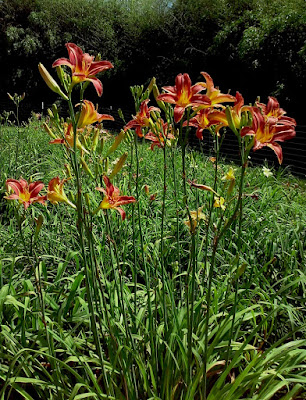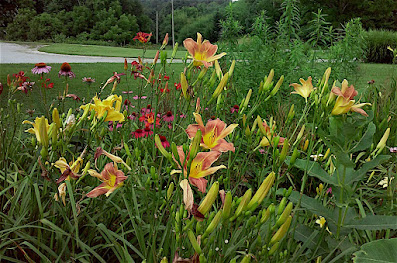The Daylily as a Permaculture Subject
I believe that the genus Hemerocallis can have multiple applications in permacultural practice. My own breeding program includes permacultural uses, as the breeding program I have elected to pursue involves backcrosses to species and species-like hybrids (often very close in generation to species) that already have application in permacultural uses.
I have written a three-part series looking at applications of the genus Hemerocallis to permaculture and other agricultural and non-floral applications. In part 1 I discuss the genus, some of the valuable species, nutritional and pharmaceutical applications and important traits for daylilies used in permacultural applications. In part 2 I look at traits of the genus Hemerocallis that make them valuable in permacultural uses. In part 3 I look at breeding daylilies for such applications.
While there is already a good number of species clones that are used for food in Asia and can be adapted to permacultural and food-forest gardens, my interest in breeding daylilies for permacultural uses is in making improvements to the nutraceutical values found within the genus, while also increasing the resistance to daylily rust and thrips (which cause enations on the buds reducing culinary value). While I do breed for improved fancy flowers for flower gardeners, that is not my only interest.
A very clear colored fulva, much brighter and cleaner than the common ditch lily, which is the fulva clone 'Europa'. This Korean clone was brought into the US in 1984 by Darrel Apps and Barry Yinger. The flowers taste very light and sweet. I suspect this is a selection for culinary use. It is an exceptional plant with high rust resistance and breeding value for rust resistance. It thrives in North America from South Florida to Mid-Canada. It should have breeding applications across the entire continent, and should work in many locations around the world.
The plants of my base plant breeding can be used to keep breeding for improved plants with the fancy flowers collectors want, but those which have the best permacultural traits can be selected from amongst them for focus on those traits. The interesting thing that I am finding is that the improvements in thrip resistance also seems to create a much more durable and attractive flower, while the taste of the flower petals seems to have some correlation to color clarity. Both traits are of value in breeding for attractive garden flowers, as well as for breeding tastier and more durable flowers.
Four of my spring 2019 introductions have applications for permacultural uses. Two of those introductions, I believe, are especially valuable for permacultural applications - Eos At Dawn and Korean Queen. Those two are also base plants from my breeding program, representing the blending of species and species-like base plants. The other two are Korean Mother Of Pink and Korean Mother Of Purple. Both are hardy here, but are more tender than my climate needs. These would have applications in program with warmer winters than I experience in USDA zone 6. I think they would be best in zone 8 or higher, but for people working in those areas these will be useful. From the founding of my program in 2010, permacultural applications have been important to my work, and the four species base plants were all accessed either fall of 2010 or spring of 2011. These four introductions date to that early part of my breeding work in 2011 and 2012.
My program is based upon making my own base plants to breed both flower phenotype daylilies for gardeners and plants with permacultural applications. All facets of my program derive from the development of my base plants. To develop them, I have selected four superior plants that are either a species clone or very close to the species. Others have done such work with daylilies, but they have tended to work at the diploid level. My focus is to create my program within polyploid populations with a focus on tetraploidy. From the base plants, crosses to select plants with advanced flower phenotypes are used to create stronger, more disease resistant garden populations, while crosses of those individuals with the best permacultural applications can work to create improved plants, as well as individuals with select nutraceutical traits. A long term goal would be to combine and intensify the select traits.
However, in no line of breeding do I ignore the flower. The species daylilies are attractive. Noting that there appears to be a correlation between the flavor of the petals and the clarity of the color, this suggests that the common hobby selection-focus of "clean colors" may also apply to breeding and selecting for culinary applications. The lack of the rough, bumpy enations on the backs of the sepals is essential for a good culinary daylily. I have begun to experiment with the various types of color, both carotenoid and anthocyanic. In many food plants, these pigments are important parts of both the nutrition profile and the flavor. For instance, the anthocyanic red lettuce cultivars have a different flavor than regular green lettuces.
It seems to me at this time that some of the darker anthocyanic pigments found in Hemerocallis hybrids also gives a stronger, somewhat more astringent flavor to the petals, while pale yellows, lavender, pink and near white are often very light and sweet. I see no reason that permacultural daylilies would have to be either identical to the species in terms of flower phenotype, nor why they would need to not be attractive, perhaps even wildly so. I think permaculture can be beautifully designed to your taste and still be natural and useful. If a positive correlation is found between attractive colors and useful traits, then the sky is the limit in terms of useful permacultural applications along with beautiful flowers.
In experimenting with the flowers of the hybrid cultivars, I have found that some of them are good to eat, while others have odd, sedative effects, and others are almost laxative in nature. I don't think anyone should ever assume that just any daylily is perfectly edible. The genus has a lot going on chemically, and the hybrids are a mish-mash of the genes for those traits, all randomly assorted due to never having been selected for. However, as I have very carefully experimented with the hybrids, I have been able to make some selections for both attractive modern traits and palatability. I suspect by blending those with my species-like base plants, that the selection for the most palatable flowers may also open the door for some exciting flowers as well. Nothing ever has to be just one thing.






